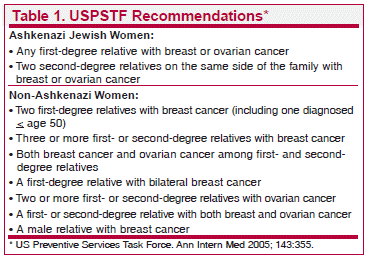ISSUE1274
Direct-to-consumer advertisements are urging women to be tested for mutations in BRCA1 and BRCA2 genes, which are the most common known causes of an inherited predisposition to breast and ovarian cancer. Clinically important BRCA mutations have been found in about 2% of Ashkenazi Jewish women, and are estimated to occur in about 1 in 300 to 500 women in the general non-Jewish US population.1 The prevalence appears to be lower in non-whites.
WHO SHOULD BE SCREENED? — If the youngest woman in the family who has breast or ovarian cancer tests negative for BRCA mutations, further testing of the family may not be indicated.
BRCA genes can be inherited from either parent. The family histories that warrant consideration of testing, according to the US Preventive Services Task Force, are listed in the table below.When a woman tests positive, her first- and second-degree female relatives, and possibly her female cousins, should also be tested.

MANAGEMENT OF A POSITIVE TEST — A recent meta-analysis calculated that women who test positive for the BRCA1 mutation have a 57% risk of developing breast cancer and a 40% risk of developing ovarian cancer before age 70, and those who test positive for the BRCA2 mutation have a 49% risk of developing breast cancer and an 18% risk of developing ovarian cancer.2
Since the onset of cancer occurs at an earlier age in BRCA mutation carriers than in the general population, BRCA-positive women might consider having breast and gynecological exams every 6 months beginning at age 25 and an annual breast MRI, with or without mammography, at age 30. MRIs detect twice as many cancers as either mammography or ultrasound.3-5 A mammogram in addition to an MRI would further increase the sensitivity of breast cancer detection, but ionizing radiation may itself induce cancer in BRCA-mutation carriers, and the benefit may not justify the radiation exposure before age 35.6 Use of a mammogram, MRI and ultrasound all together increases the sensitivity of breast cancer detection from about 75% with an MRI alone to about 95%.
At some point, BRCA-positive women should consider a bilateral salpingo-oophorectomy, which reduces the risk of ovarian cancer by at least 80% and also reduced the risk of breast cancer by 50% in some reports.7,8 Preventive bilateral mastectomy can reduce the risk of breast cancer by 90% or more.
CONCLUSION — Women with no family history of breast or ovarian cancer on either side of the family generally should not be tested for BRCA mutations. Women with a strong family history of breast or ovarian cancer and female relatives of women who test positive for BRCA mutations probably should be tested because effective surveillance and preventive measures are available.
1. US Preventive Services Task Force. Genetic risk assessment and BRCA mutation testing for breast and ovarian cancer susceptibility: recommendation statement. Ann Intern Med 2005; 143:355.
2. S Chen and G Parmigiani. Meta-analysis of BRCA1 and BRCA2 penetrance. J Clin Oncol 2007; 25:1329.
